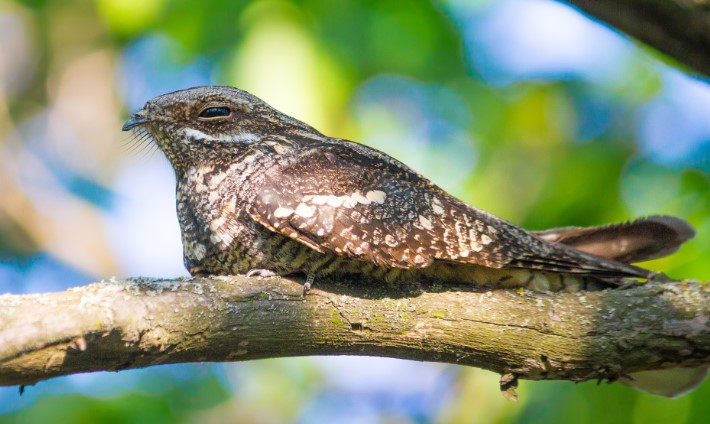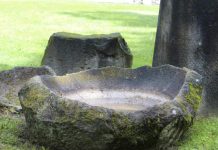One of the most commonly seen nightjars in Australia, the Spotted Nightjar or spotted eared-nightjar is often seen on inland roads. As it flies off in the darkness, the car headlights reflect its ruby-red eyes and white wing patches. It replaces the White-throated Nightjar west of the Great Dividing Range, with whose habits it shares a great deal. Among its natural habitats are open forests, woodlands, scrubland, spinifex and tussock grasslands, savannah woodland, and mangrove forests.
In the same way as that species, the Spotted Nightjar roosts by day on low, sparsely shrubbed and wooded ridges both sandy and stony; during the first and last hours of the night, it hunts on the wing for nocturnal flying insects, primarily beetles, and moths, with the same erratic and jerky stiff-winged flight pattern. As well as moving north after breeding, southern Spotted Nightjars can also be found on islands in the Banda and Bismarck Seas.
They live in loose groups of 10-15 when moving about, but are solitary or dispersed in pairs when breeding or wintering. Because Spotted Nightjars live in such exposed habitats, they have special physiological capabilities for lowering their body temperatures and cooling themselves. Their roosts are also oriented the other way around during the day, so they have their backs to the sun during the day. White-throated Nightjar behavior is similar to that of the White-throated Nightjar in other aspects, such as disturbances at the nest and threat displays.
In terms of size, Spotted Nightjar is approximately 290-310 mm long. ADULT: Males and females alike. The upper parts are mid-gray speckled with white, and marked with tawny and black, with a completely tawny collar. During the flight, large white spots form a conspicuous bar at the end of the wing; flight feathers are dusky, spotted ochreish. Its throat and breast are flecked and barred tawny and black, with two large white patches forming broad bars on the throat; its belly and crissum are plain tawny. Grey tail with fine black bars.
There is a deep brown color to the eyes. The bill and feet are sepia to dusky in color. As an adult, the upper parts are mainly cinnamon russet, while the lower parts are duller than the upper parts. During the first year after fledging, adult plumage is gained. DOWNY YOUNG: Reddish brown to chestnut-colored.
The territorial and contact call is a deliberate series of two-three rising mellow caws, followed by a quick run of eight- fifteen clinking double-notes or gobbles on the same pitch; given erratically by both sexes during breeding. There are also occasional grunts, chopping notes, and hisses; otherwise, it is silent. As birds approach their nesting area, they may emit low croaking and frog-like croaking sounds. During nesting and territorial contact, downy young cheep a continuous beep, beep, beep. During the flight, they both eat and drink from water holes, skimming along the surface of the water.
The nesting and breeding season occurs between September and January, the earliest in the north. There is only one brood per season. There is no nest; the egg is laid and incubated among the ground litter. There are a variety of prey species, including bugs, beetles, moths, winged ants, grasshoppers, locusts, and lacewings.
Eggs are usually greenish cream and sparsely but boldly spotted and blotched purple-brown and blackish mauve. They are broad-ellipsoidal and measure 32-37 x 23-26 mm. Both sexes incubate for about 20 days. Four weeks after hatching, the young are nidifugous, brooded, and fed by both adults.
All mainland west of the Great Dividing Range and offshore islands are home to Spotted Nightjars; Kangaroo Island and Tasmania have not been recorded. On migration, reaches islands just north of Australia. There are no races. The spotted nightjar is an insectivorous nocturnal bird that mostly roosts and perches on the ground rather than in trees. Read More – 16 Facts of Eurasian Wryneck







